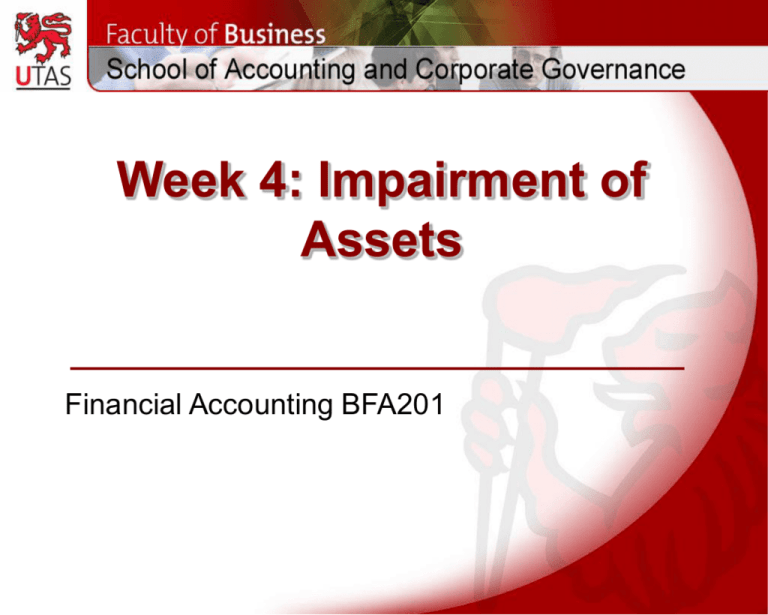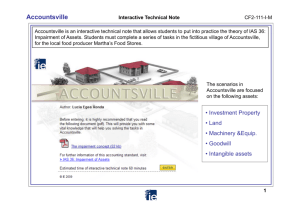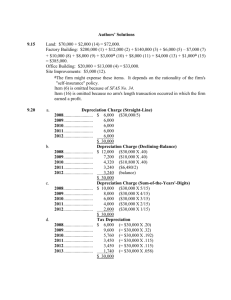
Week 4: Impairment of
Assets
Financial Accounting BFA201
Learning Objectives
To demonstrate your understanding of the following:
• How and when to revalue an item of property,
plant and equipment
• Upward revaluations to ‘fair value’ and downward
revaluations to ‘recoverable amount’
• Impairment losses and how to account for them
2
Readings and references
• Deegan Chapter 6
• AASB 116 Property, Plant and Equipment
• AASB 136 Impairment of Assets
3
Independent Study Tasks
Tutorial questions (for workbooks)
• What does the ‘impairment of an asset’ mean? How
should impairment of an item of property, plant and
equipment be accounted for?
• Deegan Challenging Questions 22 and 25 from
Chapter 6
Independent study questions (not for workbooks)
• Deegan Chapter 6 Review Questions 3, 16, 19 and an
additional question (Quiggly Ltd) on MyLO
4
Introduction to Revaluations
• Criticisms of historical cost
• Option to revalue non current assets
• Asset revaluations – what are they?
• Reassessment of the carrying amount of a noncurrent asset to fair value as at a particular date
(excludes impairment)
5
Measurement: AASB 116
Asset Measurement Models
Based on Asset Classes (para. 29)
Cost Model
Revaluation Model
(para. 30)
(para. 31)
• Original COST
• FAIR VALUE
• Depreciation
• Regular revaluation
• Impairment loss AASB 136
• Impairment loss AASB 136
6
Cost model – para 30
• Gross carrying amount (acquisition cost)
Cost
Loss /
Expense
NBV
Carrying
value
Gross
carrying
amount –
NEVER
changes
Accum
Dep &
Impair
7
Revaluation value model AASB
116 para. 31
• Gross carrying amount (fair value)
Fair
value
Expense/
Reval
NBV
Carrying
value
Class of
assets
regularly
revalued
Accum
Dep &
Impair
8
Choice: COST or FAIR VALUE?
• Same Class = same model
F
V
Land &
Buildings
C
o
s
t
Office
Equipment
F
V
Aircraft
C
o
s
t
Motor
Vehicles
• Any revaluation
fair value
• Able to be measured reliably; sufficient regularity
9
AASB 116: Disclosure
requirements (para 73-79)
• For each class of depreciable asset, the following
must be disclosed:
– Measurement bases used for determining
gross carrying amount
– Depreciation methods used
– Useful lives or depreciation rates used
– Gross carrying amount and accumulated
depreciation at the beginning and end of the
period
– Detailed reconciliation of the carrying amount
at the beginning and end of the period
10
Impairment AASB136
•
Both models (cost and revaluation) refer to
impairment (AASB 136)
• Are assets overstated? Test for impairment:
– asset’s carrying amount (CA) is MORE than
its recoverable amount (RA)
•
Exempted from test:
–
–
–
–
–
Inventories
Construction contracts
Assets from Employee benefits
Deferred tax assets
Assets held for resale
The specific requirements
in relation to these assets
are covered in the AASBs
that deal with these
balances
11
Impairment of assets
• AASB 136
• Q - Any
indication of
impairment ?
Reporting
date
assessment
Impairment
Test
• Calculate RA
• Is carrying value >
recoverable
amount ?
• MUST write
down to
recoverable
amount
Impairment
Loss
• Revalued asset?
• Treat as revaluation decrease
12
When to test for impairment?
• When there is an indication (or evidence) of
impairment
• Each reporting period – assess indicators
• The following assets must be tested annually
for impairment:
• Intangibles with indefinite useful lives
• Intangibles not yet available for use
• Goodwill acquired in a business
combination
Reason annual testing is required … the CA of these
assets is more uncertain than that of other assets
13
Indicators of impairment
For individual assets or cash-generating units:
• EXTERNAL
– Market declines
Not
– Technological changes
impaired?
– Economic or legal changes
Ask if
previously
– Interest rates
impaired?
– Net assets > market capitalisation
Yes!
• INTERNAL
Reverse.
– Obsolete
– Physical damage
– Restructuring
– Poor performance
14
Cash-generating units (CGUs)
• “the smallest identifiable group of assets that generates
cash inflows that are largely independent of the cash
inflows from other assets or groups of assets”
(AASB136: para 6)
• RA = The higher ↑ of Fair Value Less Costs to Sell
(FVLCTS) and Value In Use (VIU)
• Individual machine in a factory?
– Value due to relationship with other assets
• Impairment allocated to cash-generating unit (CGU)
• IMPAIRMENT LOSS - pro-rata basis
15
Measuring Recoverable Amount
.
Carrying
amount
is
compared
to
Recoverable
amount
Which is the higher of?
Fair value less
costs to sell
Value in use
16
Fair value less costs to sell
• Measured in accordance with;
– AASB 13 Fair Value Measurement
– The price that would be received to sell an
asset or paid to transfer a liability in an
orderly transaction between market
participants at the measurement date
(Appendix A)
• Two parts to the definition:
• Fair value
• Costs of disposal
BFA201_13
17
Value in use
• “ … the present value of future cash flows expected
to be derived from an asset or cash-generating unit”
para 6
• 5 elements (para 30)
1. Estimate of future cash flows
2. Possible variations in future cash flows
3. Time value of money
4. Risk factor
5. Other factors eg. illiquidity
• STEPS (para 31):
1. estimate future cash flows
2. apply a discount rate
18
Value in use –
determining the discount rate
• The discount rate should reflect:
The pre-tax time value of money
• The entity’s WACC
• The entity’s incremental borrowing rate
• Other market borrowing rates
The risks specific to the asset for which future cash
flows have not been adjusted
• Country risk
• Currency risk
• Price risk
19
Recording an impairment loss for
an individual asset
• Impairment loss = CA > RA
• Cost model: impairment loss is recognised
immediately in profit and loss
20
Cost model: Impairment Loss
Suppose an asset having a carrying amount of $100
(original cost $160, and accumulated depreciation $60)
has a recoverable amount of $90
The journal entry for the impairment loss would be:
30 June
X8
Impairment loss
10
Accumulated depreciation
and impairment losses
10
To record the Impairment
loss on asset
Depreciation expense now based on recoverable amount.
Eg. If residual value 0 and useful life remaining 3 yrs = 90/3 = $30 pa
21
Revaluation (NOT cost model)
• Revaluation increments AASB 116 para. 39 part of
owners’ equity (other comprehensive income) not P&L
• DR
Asset
CR
XXXX
Revaluation surplus XXXX
• However there is an exception to this as include in
P&Lwhere it is reversing a previous decrement (see
later)
22
Lecture Example 1
• If land recorded at $200,000 and latest valuation is
$250,000, then the net effect is:
Debit
Land (Asset)
$ 50 000
Credit
Revaluation surplus $ 50 000
» If it is a depreciating asset always write down asset to its carrying
amount first (see later)!
23
Revaluation Increments
HOWEVER:
If
increase reverses
a previous
revaluation
decrease
It must be recognised in profit & loss
24
Lecture Example 2
• From previous example, land acquired for $200 000;
revalued to $250,000.
• Journal entries: Dr Land $50 000
Cr Reval. surplus
$50 000
• A new airport is located near the land resulting in a
decline in the value of the land to $147 000.
• Decrement required is $250 000 - $147 000 = $ 103 000
Journal entry:
Dr Revaluation Surplus
$50 000
Dr Loss on Revaluation (expense) $53 000
Cr Land
$103 000
25
Revaluation decrements
AASB 116 para. 40
Decrease to Profit & Loss
DR Loss on revaluation (expense) XXXX
CR Land
XXXX
HOWEVER if
decrease
reverses
a previous
revaluation
increase
DR Revaluation surplus (upward reval.)
DR Loss on revaluation (any excess)
CR Asset
(total revaluation)
[Note: always check if you need to first reverse a previous revaluation]
26
Lecture Example 3
1/7/07: Z Ltd purchased land for $200,000 (Reval. Model)
30/6/08 - revalued to fair value $150,000
30/6/10 – revalued to fair value $210,000
1/7/07
Dr
Land
Cr
30/6/08 Dr
$200,000
Cash
$200,000
Loss on revaluation $50,000
Cr
Land
$50,000
30/6/10
Dr Land
$60,000
Cr Gain from reversal of previous revaluation
Cr Revaluation Surplus
$50,000
$10,000
27
Revaluing Depreciable Assets
• Gross method OR
• Net-amount method
NET METHOD:
1st
• Depreciate
• (for prior period if applicable)
2nd
• Close Accum.Depreciation A/c
• DR Acc Dep; CR Asset
3rd
• Revalue NET amount
• DR / CR asset
• Next period – Recalculate depreciation
28
Lecture Example 4
• Durango Ltd purchased an item of plant on 1 July 2000
and chose the revaluation model to account for assets
in that class. The plant cost $100 000 and was to be
depreciated using the straight line basis over 20 years.
On 30 June 2002 its fair value was $180 000, while on
30 June 2004 it’s fair value was $50 000. On 1 July
2004 the plant was sold for $60 000.
Required
• Prepare the journal entries to record the above events
in accordance with AASB 116 ‘Property, plant and
equipment’. Use the net amount method for your
treatment of accumulated depreciation.
29
Solution
1/7/X0
Plant
Cash at bank
DR
100,000
CR
100,000
30/6/X1 Depreciation expense
Accumulated depreciation - Plant
5,000
30/6/X2 Depreciation expense
Accumulated depreciation - Plant
5,000
Accumulated depreciation
Plant
10,000
Plant
Revaluation surplus
90,000
5,000
5,000
10,000
90,000
30
Solution cont.
30/6/X3 Depreciation expense
Accumulated depreciation - Plant
10,000
30/6/X4 Depreciation expense
Accumulated depreciation - Plant
10,000
1/7/X4
10,000
10,000
Accumulated depreciation
Plant
20,000
Revaluation surplus
Loss on revaluation
Plant
90,000
20,000
Cash at bank
Gain on disposal
Plant
60,000
20,000
110,000
10,000
50,000
Revaluation surplus =$0; No entry to retained earnings
31
Recording an impairment loss for
an individual asset : revaluation
model
• Impairment loss = CA > RA
• Revaluation model - impairment loss is
treated as a revaluation decrement
• Subsequent depreciation/amortisation is
based on the new recoverable amount.
32
Lecture Example 5
• Asset has carrying amount of $100 (fair value of
$120 and accumulated depreciation $20) and a
recoverable amount of $90.
• How does your answer change if the carrying
amount of $100 was the result of a previous
revaluation?
33
Solution
• Journal Entries:
Dr Accumulated depreciation
Cr Asset
Dr
Revaluation write-down
Cr Asset
20
(120 – 100)
20
10
(100 – 90)
10
• If the revalued asset had a previous revaluation:
Dr Revaluation surplus
10
Cr Asset
10
34
Lecture Example 6: Impairment
losses and CGUs
• A Ltd has identified an impairment loss of $12,000
on one of its CGUs
• The CGU consists of the following assets (stated at
current carrying amounts):
Buildings
$500,000
Equipment
$300,000
Land
$250,000
Fittings
$150,000
a) Calculate the allocation of impairment loss against
all assets in the CGU.
b) Recalculate if the FVLCTS of the building is
$497,000.
35
Solution a)
CA
Pro- Impairment
rata
loss
allocated
5/12
5,000
Buildings 500,000
3/12
3,000
Equipment 300,000
2,500
Land
250,000 2.5/12
1,500
Fittings
150,000 1.5/12
1,200,000
Adjusted
CA
495,000
297,000
247,500
148,500
12,000
36
Solution b)
If the FV of the building is $497,000 this is the max to
which these assets could be reduced. Balance of $2,000
needs to be allocated across the other assets in the CGU
Adjusted
CA
Prorata
Impairment
Total
loss
impairment
allocated
loss
allocated
Buildings
Equipment
3,000
Land
297,000
247,500
Fittings
148,500
693,000
From last
column of
previous slide
247.5/693
857
714
3,857
3,214
148.5/693
429
1,929
2,000
12,000
297/693
37
Solution cont.
General Journal Entries:
Dr
Cr
Impairment Loss
$12 000
Acc.dep.& impair losses – Building
$3 000
Acc.dep.& impair losses – Equipment $3 857
Land
$3 214
Acc.dep. & impair losses – Fittings
$1 929
(Recognition of the impairment losses)
38
Reversal of impairment losses
• Impairment losses: reassessed annually
• If recoverable amount now exceeds the carrying
amount:
– The asset’s carrying amount is increased to its
recoverable amount; and
– An income item ‘reversal of impairment loss’ is
recognised (offsetting prior expense)
39
Reversal of impairment losses
cont.
• Recoverable amount exceeds carrying amount:
– If previously revalued then CR Revaluation Surplus
– CANNOT REVERSE IMPAIRMENT ON GOODWILL
• NOTE: the carrying amount cannot be increased to an
amount in excess of the carrying amount that would have
been determined had no impairment loss been
recognised.
• i.e. RE-WORK DEPRECIATION
40
Lecture Example 7
• On 30 June 2005 Ablett Ltd owns an item of
factory machinery. It has an original cost of $200
000 with accumulated depreciation of $40 000
(one year’s depreciation). It is being depreciated
on a straight line basis over 5 years and it is
estimated that it has no residual value.
• On 30 June 2005, Ablett Ltd estimates that the
factory machinery is impaired (certain indicators
are that the present value of net cash flows from
the machine are lower than expected), as its
value in use is estimated to now be $120 000.
41
Lecture example 7 cont.
• On 30 June 2006 (after depreciation for the year
has been recorded), information comes to light that
the output of the factory machinery will be
significantly in demand in future years and that the
machinery’s value in use is now $170 000.
Required
Show journal entries relating to this asset on
• 30 June 2005,
• 30 June 2006 and
• 30 June 2007.
BFA201_13
42
Solution
30/6/X5
30/6/X6
Impairment loss
Accumulated depreciation and impairment losses
Recording impairment loss (200,000 - 40,000) -120,000
40,000
Profit and loss
Impairment loss
Closing entry
40,000
Original cost
Accumulated depreciation and impairment losses
Depreciation this year (120,000/4)
CARRYING AMOUNT
Recoverable Amount at 30/6/X6
40,000
40,000
Now
200,000
80,000
30,000
90,000
170,000
Accumulated depreciation and impairment losses
Income - impairment loss reversal
To record impairment loss reversal (120,000 - 90,000)
30,000
Income - impairment loss reversal
Profit and loss
Closing entry
30,000
Without
impairment
loss
200,000
40,000
40,000
120,000
30,000
30,000
43
Solution cont.
30/6/X7
Depreciation
Accumulated depreciation and impairment losses
To record depreciation for the year (120,000/3)
40,000
Profit and loss
Depreciation
Closing entry
40,000
40,000
40,000
44
Economic consequences of
asset revaluations
• If contracts in place are tied to reported profits (debt
or management compensation), management might
have an incentive not to revalue
• However, if assets are increased a revaluation might
loosen constraints such as debt-to-assets restrictions
• Firms subject to political scrutiny might be more likely
to undertake upward revaluation resulting in a
reduction in profits
• As the perceived competence of independent valuers
increases, audit time might be reduced
45
Next Week
Accounting for Intangible Assets and Goodwill
© Copyright University of Tasmania, School of Accounting & Corporate
Governance
All rights reserved.
Commonwealth of Australia Copyright Regulations 1969 - WARNING
This material has been reproduced and communicated to you by or on behalf of the University
of Tasmania pursuant to Part VB of the Copyright Act 1968 (the Act). The material in this
communication may be subject to copyright under the Act. Any further reproduction or
communication of this material by you may be the subject of copyright protection under the Act.
Do not remove this notice.







